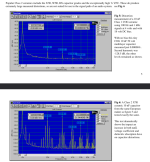What's the consensus of X7R vs C0G in pedals?
I know the audiophile consensus but here's the thing. I have a decent stock of tayda and AliExpress sourced X7Rs because, I have a problem, and also I want to build when I want to/have time to build. I never once thought to myself "I wonder if the electrolyte in MLCCs are different and it matters."
Instead, it was more like "it's a ceramic but less badder for audio."
Then the great and powerful Bean and his wordy build docs reached through the portable document format of the degerator and put the fear of dog in me today. I already didn't like them, to be fair.
Anyway, I do have both an AE and EE background, kinda(tech audio degree and a AAS in EE) so I kinda feel stupid even posting this, but hey, I made an assumption that ceramic sucks, MLCC is like a ceramic Big Mac, better but still sucks. But oh s**t, some Big Macs may be non-linear turd Macs?
Honestly, in fuzzes and such, I don't care. Give me all the non linearities ya got. I'm more worried about the early stages in a 4 stage gain stage, or a digital system or something 'clean'.
So, Fox News me people. Tell me when to worry about the boogie caps coming to take my noisefloor.
Also, I'm not so inclined to keep two types in inventory. I have maybe $20-30 in them. It's worth it to me to donate them to a local youth group and restock if needed to avoid "why is my bonk machine making clown noises when it's hot?" posts. It's a hobby. It's not meant to save money. It's also not meant to deprive sanity either.
I know the audiophile consensus but here's the thing. I have a decent stock of tayda and AliExpress sourced X7Rs because, I have a problem, and also I want to build when I want to/have time to build. I never once thought to myself "I wonder if the electrolyte in MLCCs are different and it matters."
Instead, it was more like "it's a ceramic but less badder for audio."
Then the great and powerful Bean and his wordy build docs reached through the portable document format of the degerator and put the fear of dog in me today. I already didn't like them, to be fair.
Anyway, I do have both an AE and EE background, kinda(tech audio degree and a AAS in EE) so I kinda feel stupid even posting this, but hey, I made an assumption that ceramic sucks, MLCC is like a ceramic Big Mac, better but still sucks. But oh s**t, some Big Macs may be non-linear turd Macs?
Honestly, in fuzzes and such, I don't care. Give me all the non linearities ya got. I'm more worried about the early stages in a 4 stage gain stage, or a digital system or something 'clean'.
So, Fox News me people. Tell me when to worry about the boogie caps coming to take my noisefloor.
Also, I'm not so inclined to keep two types in inventory. I have maybe $20-30 in them. It's worth it to me to donate them to a local youth group and restock if needed to avoid "why is my bonk machine making clown noises when it's hot?" posts. It's a hobby. It's not meant to save money. It's also not meant to deprive sanity either.
Last edited:

